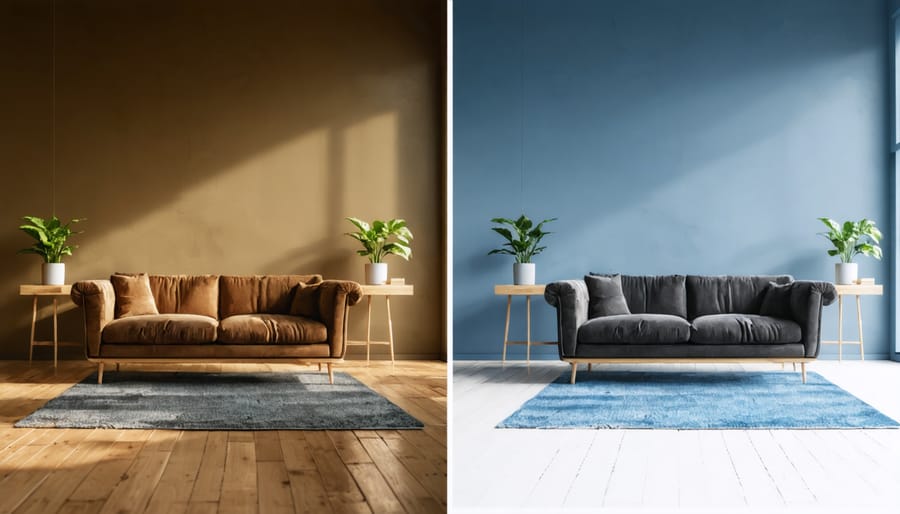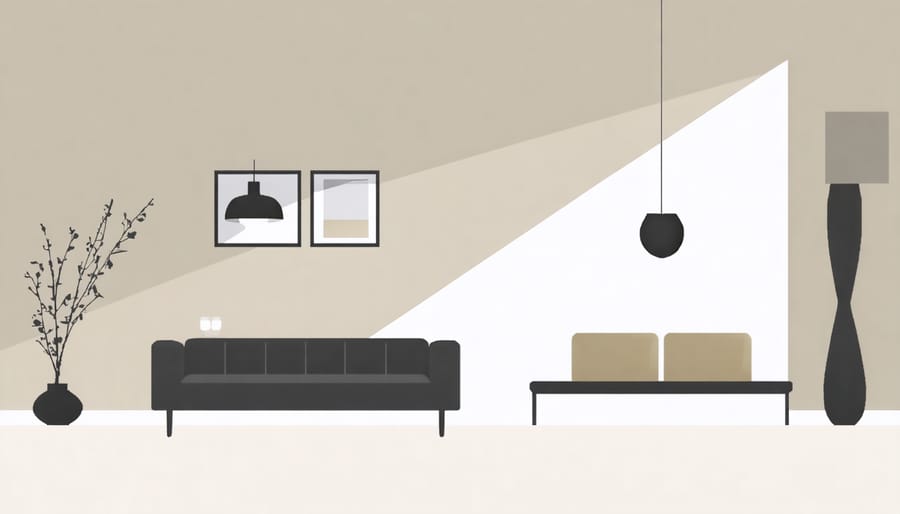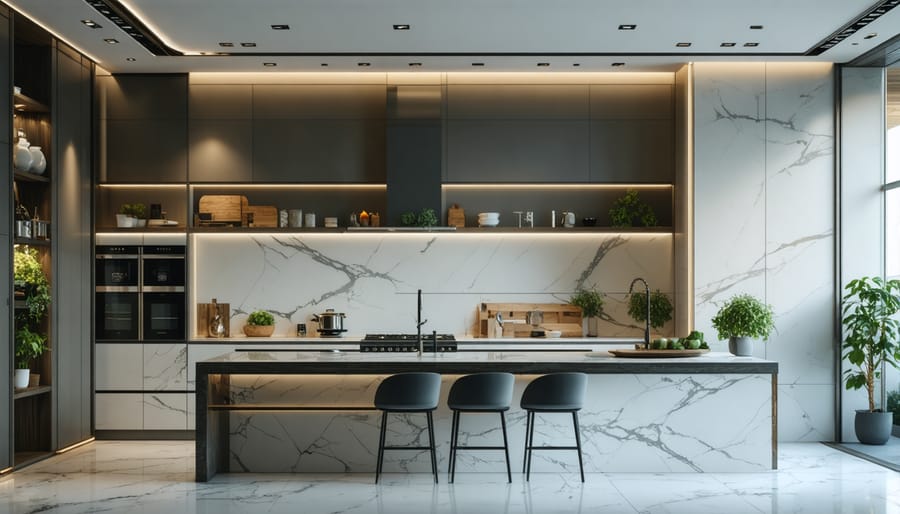Transform any room into a perfectly illuminated space by mastering the three fundamental layers of lighting: ambient, task, and accent. Position overhead fixtures strategically to create a base layer of light that reaches every corner, while eliminating harsh shadows and dark spots. Install adjustable wall sconces or table lamps at eye level to provide focused task lighting for reading, cooking, or working. Add depth and personality through carefully placed accent lights that highlight architectural features, artwork, or decorative elements.
Proper room illumination directly impacts mood, productivity, and comfort. Natural light works in harmony with artificial lighting to create dynamic, livable spaces throughout the day. Smart lighting systems offer precise control over brightness levels and color temperature, automatically adjusting to match your daily routines and activities. Understanding the interplay between light fixtures, room dimensions, and surface materials enables you to create sophisticated lighting designs that enhance both form and function.
The key to successful room illumination lies in balancing practical needs with aesthetic goals. Consider the room’s purpose, existing décor, and architectural elements when selecting light fixtures and planning their placement. Layer different light sources at various heights and intensities to create visual interest while ensuring optimal visibility for every task and occasion.
The Science Behind Perfect Room Lighting
Natural vs. Artificial Light Balance
Achieving the perfect balance between natural and artificial light can transform your living space while saving energy. Start by maximizing daylight during peak hours through clean windows and strategic furniture placement that doesn’t block light sources. Position mirrors opposite windows to bounce natural light deeper into your room.
Layer your artificial lighting to complement natural light throughout the day. Install dimmer switches to adjust artificial light levels as natural light changes. During early mornings and late afternoons, use warm-toned lights to supplement fading daylight without overwhelming the natural ambiance.
Consider installing light sensors or smart bulbs that automatically adjust their brightness based on available natural light. Place task lighting in areas where shadows commonly fall during the day, such as reading nooks or workspace corners. Use sheer curtains or adjustable blinds to control glare while maintaining natural light flow.
Remember that different seasons require different approaches. In winter, when daylight is scarce, focus on creating warm, inviting artificial light. During summer, you might need less artificial lighting but more glare control. The key is creating a flexible system that adapts to both daily and seasonal changes in natural light.
Color Temperature and Mood
Color temperature plays a crucial role in creating the perfect light and color harmony in your living spaces. Warm lighting (2700-3000K) creates a cozy, inviting atmosphere that’s perfect for living rooms and bedrooms. Think of the soft, golden glow of sunset – this type of lighting helps you relax and unwind after a long day.
Cool lighting (4000-5000K), on the other hand, mimics natural daylight and helps keep you alert and focused. It’s ideal for home offices, kitchens, and bathrooms where tasks require attention to detail. This bluish-white light can enhance productivity and make colors appear more vibrant and true-to-life.
The secret to successful room illumination lies in matching the color temperature to your room’s purpose. For entertaining spaces, consider using warm lights to create an intimate atmosphere. In work areas, cool lighting helps maintain energy levels and reduces eye strain. You can even install smart bulbs that adjust their color temperature throughout the day, supporting your natural circadian rhythm and enhancing your overall well-being.


The Three Layers of Room Lighting
Ambient Lighting Solutions
Ambient lighting serves as the foundation of any well-lit room, providing overall illumination that sets the mood and ensures comfortable visibility. Start with ceiling-mounted fixtures or recessed lights positioned strategically around the room’s perimeter. For living rooms and larger spaces, aim to place lights approximately 5-6 feet apart to create even coverage without harsh shadows.
Consider installing wall sconces at eye level (typically 5.5-6 feet from the floor) to add depth and eliminate dark corners. These work particularly well in hallways and dining areas. For rooms with high ceilings, pendant lights or chandeliers can fill the vertical space while providing essential ambient light.
Natural light plays a crucial role too. Position mirrors opposite windows to maximize daylight distribution throughout the space. For rooms with limited natural light, consider using LED strip lights behind crown molding or along cabinet tops to create subtle, indirect illumination that mimics natural light.
Remember to install dimmers for your ambient lighting sources. This simple addition allows you to adjust light levels throughout the day and create different moods for various activities.
Task Lighting Essentials
Task lighting is your secret weapon for getting things done efficiently and comfortably in any room. Whether you’re chopping vegetables in the kitchen, reading your favorite book, or working on detailed crafts, proper task lighting makes all the difference.
For your home office or study area, position an adjustable desk lamp about 15 inches above your work surface to prevent eye strain. Look for lamps with multiple brightness settings and color temperature options to match your activity and time of day.
In the kitchen, under-cabinet lighting isn’t just stylish – it’s practical. Install LED strips beneath your upper cabinets to illuminate countertops where you prep meals. For bathroom vanities, consider installing sconces at eye level on both sides of the mirror to eliminate unflattering shadows while grooming.
Remember to layer your task lighting with the room’s ambient light. A reading nook benefits from a focused floor lamp that complements your ceiling fixture, while craft areas might need a combination of overhead and tabletop lighting for optimal visibility. Choose bulbs with a color rendering index (CRI) of 90 or higher to ensure colors appear true and details remain crisp.
Accent Lighting Techniques
Accent lighting adds that extra touch of magic to your room, creating depth and visual interest while highlighting your favorite features. Start by identifying key focal points – this could be artwork, architectural details, or decorative elements you want to showcase. Consider using small LED spotlights or adjustable track lighting to direct focused beams onto these features.
Layer your accent lighting by combining different techniques. Try placing strip lights under cabinets or along crown molding for a subtle glow, or use wall sconces to create interesting shadow patterns. Picture lights mounted above artwork not only illuminate your pieces but add sophistication to the overall room design.
Don’t forget about portable options like table lamps or floor uplights, which offer flexibility in creating ambient effects. For a contemporary touch, consider LED tape lighting behind your TV or bookshelf for a floating effect. Remember to keep accent lighting subtle – it should enhance your space without overwhelming it. Aim for about one-third the brightness of your general room lighting for the perfect balance.
Pro tip: Use dimmers with your accent lights to adjust the mood throughout the day and create different atmospheres for various occasions.
Room-by-Room Lighting Strategies
Living Room Illumination
Your living room serves multiple purposes throughout the day, from morning coffee to evening entertainment, which is why layered lighting is essential. Start with ambient lighting through ceiling-mounted fixtures or recessed lights to provide overall illumination. Add task lighting with strategically placed floor lamps near reading nooks or table lamps beside seating areas for activities requiring focused light.
Create atmosphere with accent lighting to highlight artwork, architectural features, or display shelves using wall sconces or directional spotlights. Consider installing dimmer switches to adjust light levels according to different activities and times of day. For movie nights, indirect lighting behind the TV or under cabinets can reduce glare while maintaining a cozy ambiance.
Remember to position lights at different heights to eliminate harsh shadows and create visual interest. Floor lamps work well behind sofas, while pendant lights can define dining or conversation areas within larger living rooms. LED strip lighting under floating shelves or along crown molding adds a modern touch while providing subtle illumination.
For maximum flexibility, incorporate portable lighting options that can be easily moved to accommodate changing furniture arrangements or seasonal decor changes.
Kitchen and Dining Areas
The kitchen and dining areas are multifunctional spaces that require thoughtful lighting design to support both practical tasks and create a welcoming atmosphere. In the kitchen, start with bright, shadow-free task lighting above countertops and cooking areas – under-cabinet LED strips work wonders here. Install recessed ceiling lights or track lighting to provide even, overall illumination that helps you work safely and efficiently.
For the dining area, a pendant light or chandelier centered above the table creates an inviting focal point. Choose fixtures that hang 30-36 inches above the table surface for optimal lighting and visual appeal. Consider installing a dimmer switch to easily transition from bright, functional lighting during family meals to softer, more intimate lighting for dinner parties.
Layer your lighting by combining ambient, task, and accent lights. Add small lamps on sideboards or wall sconces for extra warmth and flexibility. In open-plan spaces where the kitchen and dining areas flow together, ensure your lighting choices complement each other while defining distinct zones for different activities. Cool white lights (3000-4000K) work best in kitchen work areas, while warmer tones (2700-3000K) create a cozier dining atmosphere.
Bedroom Lighting Design
Creating the perfect bedroom lighting design requires careful consideration of both function and atmosphere. Start with a central ceiling fixture that provides adequate general lighting, but ensure it’s dimmable to adjust the ambiance as needed. Place matching bedside lamps on both nightstands for symmetry and convenient reading light – ideally positioned at shoulder height when sitting up in bed.
Layer your lighting by incorporating wall sconces or recessed lights for ambient illumination, and consider adding accent lighting to highlight artwork or architectural features. For a peaceful environment, opt for warm white bulbs (2700-3000K) that promote relaxation and natural sleep patterns.
Don’t forget task lighting for specific areas like dressing tables or reading nooks. LED strip lights behind the headboard or under floating shelves can add a subtle glow and modern touch. Install separate switches for different light sources, allowing you to create various moods throughout the day. Remember, the key is flexibility – your bedroom lighting should transition smoothly from energizing morning light to calming evening ambiance.
Bathroom Lighting Tips
Your bathroom deserves both functional and flattering lighting to create the perfect space for your daily routines. Start with overhead lighting that provides general illumination, but don’t stop there. Install vertical light fixtures on both sides of your mirror to eliminate unflattering shadows while grooming or applying makeup – this creates even facial illumination that’s essential for tasks like shaving or skincare.
Consider adding a dimmer switch to create a spa-like atmosphere for relaxing baths while maintaining the option for bright task lighting when needed. For larger bathrooms, recessed lighting can provide additional coverage without cluttering the ceiling space. Place these strategically over the shower or bathtub area for optimal visibility.
Don’t forget about natural light – if you have a window, use sheer water-resistant blinds or frosted glass to maintain privacy while maximizing daylight. For nighttime convenience, install a small motion-sensor night light to avoid harsh overhead lighting during midnight visits.
When selecting bulbs, opt for LEDs in the 2700K-3000K range for a warm, flattering glow that accurately renders skin tones. Ensure all fixtures are rated for bathroom use with appropriate IP ratings for moisture resistance.
Smart Lighting Solutions and Controls

Dimming and Scene Setting
Dimming capabilities and scene setting are game-changers when it comes to creating the perfect ambiance in your home. By installing dimmer switches, you can easily transition your space from bright and energetic to cozy and intimate with just a slide or tap. Modern smart lighting systems take this flexibility even further, allowing you to program specific lighting “scenes” for different activities or times of day.
Consider setting up scenes like “Movie Night” with subtle accent lighting, “Dinner Party” with warm overhead dimming at 50%, or “Morning Routine” with gradually brightening lights. The key is to layer your lighting sources – combine overhead fixtures, wall sconces, and table lamps on different circuits for maximum control.
Pro tip: When selecting dimmer switches, ensure they’re compatible with your bulb type (LED, incandescent, or halogen) to avoid flickering issues. Many smart lighting systems also offer voice control and scheduling features, making it even easier to set the perfect mood for any occasion.
Smart Home Integration
Transform your home into an intelligent living space with modern smart lighting control systems that make managing your room’s illumination effortless. These systems allow you to create customized lighting schedules that align with your daily routines – brightening rooms as you wake up, dimming lights in the evening, or automatically adjusting based on natural light levels.
Using your smartphone or voice commands, you can control individual lights or entire room settings from anywhere. Set up motion sensors to automatically illuminate hallways and bathrooms at night, or program vacation modes to simulate occupancy while you’re away. Many systems also integrate with other smart home devices, allowing your lights to respond to triggers like your front door unlocking or your favorite movie starting.
The real beauty lies in the energy savings – smart systems can automatically turn off forgotten lights and optimize brightness levels throughout the day, helping reduce your electricity bills while maintaining perfect illumination in every room.
Creating the perfect lighting scheme for your home doesn’t have to be overwhelming. As we’ve explored throughout this guide, thoughtful room illumination can transform your living spaces, enhance your daily activities, and create the perfect ambiance for any occasion. By combining different types of lighting – ambient, task, and accent – you can craft a layered lighting design that’s both functional and aesthetically pleasing.
Remember to consider the specific needs of each room, from bright, energizing light in your home office to soft, relaxing illumination in your bedroom. The right combination of natural and artificial light, coupled with strategic placement and proper fixture selection, can make any room more inviting and purposeful.
Start small by implementing these lighting principles one room at a time. Begin with the spaces where you spend the most time, and don’t be afraid to experiment with different bulb types, fixtures, and arrangements until you find what works best for your needs. Smart lighting solutions can add convenience and flexibility, while dimmer switches offer easy control over your room’s atmosphere.
Most importantly, let your personal style shine through in your lighting choices. Whether you prefer modern minimalism or classic elegance, there’s a lighting solution that can complement your décor while providing the illumination you need. With these principles in mind, you’re well-equipped to create beautifully lit spaces throughout your home that enhance both form and function.
